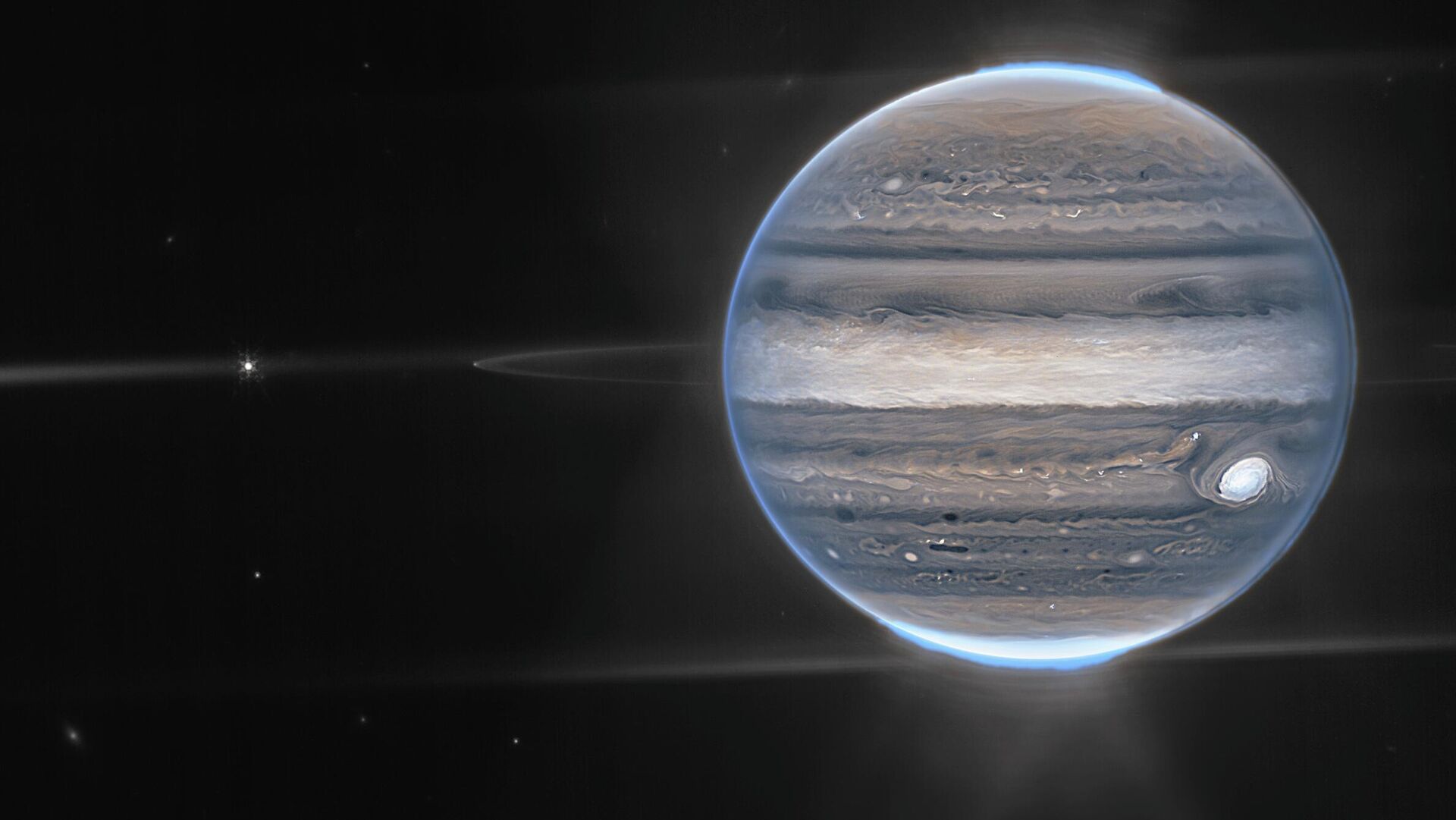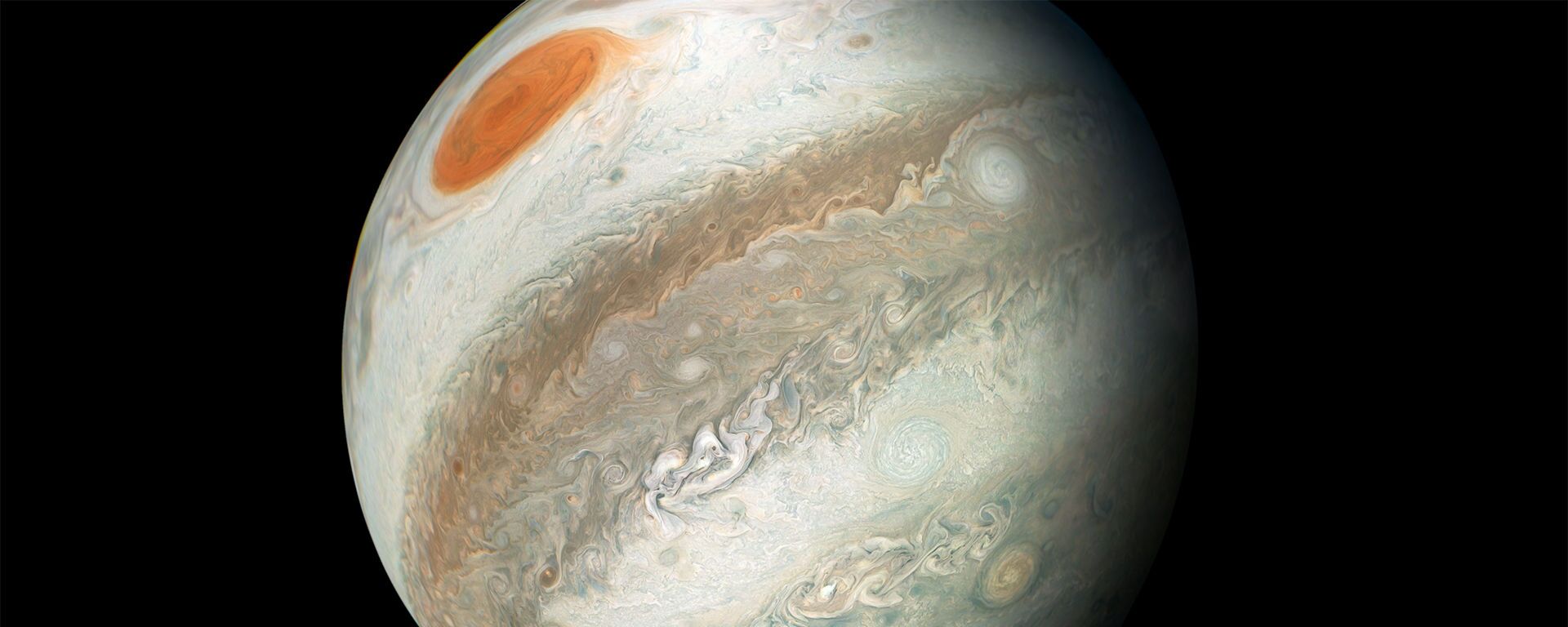https://sputnikglobe.com/20220921/nasa-jupiter-to-reach-its-closest-position-to-earth-in-six-decades-on-september-26-1101024843.html
NASA: Jupiter to Reach Its Closest Position to Earth in Six Decades on September 26
NASA: Jupiter to Reach Its Closest Position to Earth in Six Decades on September 26
Sputnik International
The largest planet in our Solar System will also be particularly visible in the evening sky because Jupiter will be in opposition, rising in the eastern sky as... 21.09.2022, Sputnik International
2022-09-21T02:38+0000
2022-09-21T02:38+0000
2023-06-20T17:11+0000
science & tech
jupiter
nasa
nasa probe
orbit
satellite
earth
space
space exploration
https://cdn1.img.sputnikglobe.com/img/07e6/09/15/1101025689_0:0:2376:1338_1920x0_80_0_0_693edeb5068b731034068a9d82fed2a7.jpg
On Monday, September 26, Jupiter will make its closest approach to Earth in 59 years, giving sky watchers a treat that evening, NASA announced.According to Adam Kobelski, NASA's Marshall Space Flight Center research astrophysicist, apart from the moon, Jupiter will likely be one of the brightest objects in the night sky.Rarely does Jupiter's closest approach to Earth coincide with its opposition, so this year's views will be exceptional, according to the agency. Jupiter will be 367 million miles (590 million km) away from Earth next Monday when it makes its closest approach, which is around the same distance as it was in 1963. At its furthest point, the enormous planet is roughly 600 million miles (some 965 million km) from Earth.Looking to the eastern horizon around sunset on the days preceding, the actual date of September 26 and the days that follow should allow for naked eye observation of the planet. However, individuals who have access to telescopes or other optical equipment will be able to see truly spectacular views of Jupiter because of its close proximity and opposition. For Jupiter and some of its more than 50 moons to put on a decent show, one will not need a lot of magnification.The scientist advised amateur astronomers to use a larger telescope to see Jupiter's Great Red Spot and bands in greater detail, adding that some filters in the green to blue spectrum might improve the visibility of these features. Kobelski claimed that the best viewing spot will be at a high elevation in a dry, dark area.The largest naturally occurring satellites of Jupiter are the four Galilean moons: Io, Europa, Ganymede, and Callisto. As early as October 2024, NASA's Europa Clipper mission could embark on a journey to study the frozen moon, which researchers believe contains a massive underground ocean.Although Jupiter has 53 identified moons, researchers estimate that a total of 79 moons have been discovered. Exploring Jupiter and its moons is the primary goal of NASA's Juno mission, according to the agency, which has been in orbit around the gas giant for six years. Five years after setting out on its trip in 2011, Juno arrived at Jupiter. The spacecraft's stunning photographs and data regarding Jupiter's dynamic atmosphere, internal features, internal magnetic field, and magnetosphere have been made available since 2016.Researchers reportedly think they can make ground-breaking discoveries about how the Solar System formed by examining Jupiter. The mission of Juno has recently been extended to 2025, or until the spacecraft's end of life.
https://sputnikglobe.com/20210609/nasas-juno-spacecraft-captures-first-close-ups-of-jupiters-largest-moon-in-decades-1083105040.html
earth
Sputnik International
feedback@sputniknews.com
+74956456601
MIA „Rossiya Segodnya“
2022
News
en_EN
Sputnik International
feedback@sputniknews.com
+74956456601
MIA „Rossiya Segodnya“
Sputnik International
feedback@sputniknews.com
+74956456601
MIA „Rossiya Segodnya“
science & tech, jupiter, nasa, nasa probe, orbit, satellite, earth, space, space exploration
science & tech, jupiter, nasa, nasa probe, orbit, satellite, earth, space, space exploration
NASA: Jupiter to Reach Its Closest Position to Earth in Six Decades on September 26
02:38 GMT 21.09.2022 (Updated: 17:11 GMT 20.06.2023) Kirill Kurevlev
Managing Editor
The largest planet in our Solar System will also be particularly visible in the evening sky because Jupiter will be in opposition, rising in the eastern sky as the Sun sets in the western part of the horizon.
On Monday, September 26, Jupiter will make its closest approach to Earth in 59 years, giving sky watchers a treat that evening, NASA
announced.According to Adam Kobelski, NASA's Marshall Space Flight Center research astrophysicist, apart from the moon, Jupiter will likely be one of the brightest objects in the night sky.
Rarely does Jupiter's closest approach to Earth coincide with its opposition, so this year's views will be exceptional, according to the agency.
Jupiter will be 367 million miles (590 million km) away from Earth next Monday when it makes its closest approach, which is around the same distance as it was in 1963. At its furthest point, the enormous planet is roughly 600 million miles (some 965 million km) from Earth.
Looking to the eastern horizon around sunset on the days preceding, the actual date of September 26 and the days that follow should allow for naked eye observation of the planet.
However, individuals who have access to telescopes or other optical equipment will be able to see truly spectacular views of Jupiter because of its close proximity and opposition. For Jupiter and some of its more than 50 moons to put on a decent show, one will not need a lot of magnification.
"With good binoculars, the banding (at least the central band) and three or four of the Galilean satellites (moons) should be visible,” Kobelski is quoted as saying. “It’s important to remember that Galileo observed these moons with 17th-century optics. One of the key needs will be a stable mount for whatever system you use."
The scientist advised amateur astronomers to use a larger telescope to see Jupiter's Great Red Spot and bands in greater detail, adding that some filters in the green to blue spectrum might improve the visibility of these features.
Kobelski claimed that the best viewing spot will be at a high elevation in a dry, dark area.
The largest naturally occurring satellites of Jupiter are the four Galilean moons: Io, Europa, Ganymede, and Callisto. As early as October 2024, NASA's Europa Clipper mission could embark on a journey to study the frozen moon, which researchers believe contains a massive underground ocean.
Although Jupiter has 53 identified moons, researchers estimate that a total of 79 moons have been discovered.
Exploring Jupiter and its moons is the primary goal of NASA's
Juno mission, according to the agency, which has been in orbit around the gas giant for six years. Five years after setting out on its trip in 2011, Juno arrived at Jupiter. The spacecraft's stunning photographs and data regarding Jupiter's dynamic atmosphere, internal features, internal magnetic field, and magnetosphere have been made available since 2016.
Researchers reportedly think they can make ground-breaking discoveries about how the Solar System formed by examining Jupiter. The mission of Juno
has recently been extended to 2025, or until the spacecraft's end of life.


